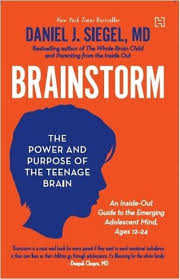
Brain Storm: The Power and Purpose of the Teenage Brain by Daniel J. Siegel. Hachette India. Pages 321. Rs 399
B. L. Chakoo
Brain changes during the early teen years set up four qualities of our minds during adolescence: Novelty seeking, social engagement, increased emotional intensity, and creative exploration. There are changes in the fundamental circuits of the brain that make the adolescent period different from childhood. These changes affect how teens seek rewards in trying new things, connect with their peers in different ways, feel emotions more intensely, and push back on the existing ways of doing things to create new ways of being in the world. Each of these changes is necessary to create the important shifts that happen in our thinking, feeling, interacting, and decision-making during our adolescence. Yes, these changes have negative possibilities, too.
However, adolescence is both a challenge and a gift, and is actually what we adults need in order to maintain ‘vitality’ in our lives. The rhetoric of popular neuroscience insists that the brain stops growing after childhood. But that is not true. The brain not only grows and changes during childhood and adolescence, but ‘continues to grow throughout the life span’. In Brain Storm — the most accessible book on adolescence, learning, creative explorations, and culture of cognitive neuroscience — Daniel J. Siegel (currently a clinical professor of neuropsychiatry at the University of California, Los Angeles) offers you the good news that the developmental state of adolescence ‘does not have to be experienced as a war between the generations’. Arguing with force and clarity, he happens to believe that if adults try to ‘block the flow of adolescence’, it is likely that communication, so significant to relationships, will be ‘tainted with tension and disrespect’. Unnecessary disconnection, ugly isolation, secrecy and many other negative and ‘hurtful social responses can emerge’.
Intelligent, flighty, charming, and extraordinarily refreshing on the age-old topics of adolescent behaviour, Brain Storm is pleasingly an altruistic book , a book that is all about comprehending and nurturing the essential features of adolescence to ‘bring the most health and happiness into the world regardless of what age we are’. Throughout, Siegel argues, very intelligently and insightfully, that when adults (caught in an oppressive, materialistic world) lose the four distinguishing features of adolescence, that is, when they ‘stop cultivating the power of novelty seeking, social engagement, emotional intensity, and creative exploration’, life, for them, can become boring, isolating, monotonous, and routinised. In fact, allowing ourselves to lose adolescent vitality will make life harder—and it also can ‘lead to not keeping the brain as strong as it could be as we age’. The results of this pioneering work, thus, challenge much of the mythic wisdom about adolescence: and in support of Freud’s theories, the author shows that when we get beyond the myths, we are able to see ‘the real truths they mask’.
Brain Storm is a full of blunt observations, reflective of the potent message it delivers to its readers, skilful unravelling of the power of the emerging ‘adolescent mind well’—which is as important for you as adolescent as it is for you as adults. Inspiring and decidedly eye- opening, the book becomes most interesting and successful when it attempts to address the question of ‘brain changes’ in adolescence by providing a broad survey of many of the major areas in adolescence and neurobiological research. It opens up a new and exciting way to think about adolescence’s potential for good.
Fascinating and just a little bit spooky, the book contains four parts, namely, The Essence of Adolescence, Your Brain, Your Attachments, and Staying Present through Changes and Challenges. All four parts make a huge contribution, showing how our adolescence is a time of great integration — ‘integration of the many aspects of ourselves’. Each part demonstrates Siegel’s gift for expounding incredibly complex concepts in language the lay reader can grasp. Here is a book which you might enjoy picking up from time to time, simply to enjoy the spectacle of a fine social and psychological intelligence at work. However, the most interesting part of the book is Staying Present through Changes and Challenges. Here we dive deep into the ways in which the changes and challenges of adolescence can best be ‘navigated by being present, by being receptive to what is happening so that we can be fully aware of the inner and interpersonal aspects of these experiences’.
The conclusion tells us that if parents and adolescents can work together to form a deeper understanding of the brain functions and its exceptional abilities, they will be able turn conflict, disrespect and violence into love, integration and compassion. In brief, this book will provide essential data and insights for both teens and parents, and working scientists interested in this dynamic field.



























